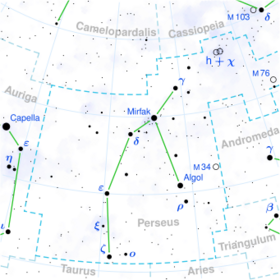Astronomy:21 Persei
| Observation data Equinox J2000.0]] (ICRS) | |
|---|---|
| Constellation | Perseus |
| Right ascension | 02h 57m 17.28228s[1] |
| Declination | 31° 56′ 03.1976″[1] |
| Apparent magnitude (V) | 5.10[2] |
| Characteristics | |
| Spectral type | A2VspSiEu[3] |
| U−B color index | −0.24[4] |
| B−V color index | −0.01[4] |
| Variable type | α² CVn[5] |
| Astrometry | |
| Radial velocity (Rv) | +8.50[6] km/s |
| Proper motion (μ) | RA: +1.319[1] mas/yr Dec.: -30.384[1] mas/yr |
| Parallax (π) | 9.8477 ± 0.2575[1] mas |
| Distance | 331 ± 9 ly (102 ± 3 pc) |
| Absolute magnitude (MV) | 0.14[2] |
| Details | |
| Mass | 3.57[7] M☉ |
| Luminosity | 88.65[2] L☉ |
| Surface gravity (log g) | 4.05[7] cgs |
| Temperature | 12,585[7] K |
| Metallicity [Fe/H] | +0.90[8] dex |
| Rotational velocity (v sin i) | 20[7] km/s |
| Other designations | |
| Database references | |
| SIMBAD | data |
21 Persei is a single,[10] variable star in the northern constellation of Perseus, located about 331 light years away from the Sun. It is visible to the naked eye as a faint, white-hued star with an apparent visual magnitude of 5.10 km/s.[2] The object is moving further from the Earth with a heliocentric radial velocity of +8.5 km/s.[6] It has the variable star designation LT Persei; 21 Persei is the Flamsteed designation.
This is an Ap star with a stellar classification of A2VspSiEu,[3] where the A2V indicates it is an A-type main-sequence star, 's' means narrow "sharp" absorption, and SiEu shows abundance anomalies of the elements silicon and europium. The star is an Alpha2 Canum Venaticorum variable, meaning that the star has a strong magnetic field chromium, silicon, and strontium spectral lines. 21 Persei's period of variability is approximately 2.88 days.[12]
References
- ↑ 1.0 1.1 1.2 1.3 1.4 Brown, A. G. A. (August 2018). "Gaia Data Release 2: Summary of the contents and survey properties". Astronomy & Astrophysics 616: A1. doi:10.1051/0004-6361/201833051. Bibcode: 2018A&A...616A...1G. Gaia DR2 record for this source at VizieR.
- ↑ 2.0 2.1 2.2 2.3 Anderson, E.; Francis, Ch. (2012). "XHIP: An extended hipparcos compilation". Astronomy Letters 38 (5): 331. doi:10.1134/S1063773712050015. Bibcode: 2012AstL...38..331A. Vizier catalog entry
- ↑ 3.0 3.1 Abt, Helmut A.; Morrell, Nidia I. (1995). "The Relation between Rotational Velocities and Spectral Peculiarities among A-Type Stars". Astrophysical Journal Supplement 99: 135. doi:10.1086/192182. Bibcode: 1995ApJS...99..135A.
- ↑ 4.0 4.1 Mermilliod, J. C. (2006). "VizieR Online Data Catalog: Homogeneous Means in the UBV System (Mermilliod 1991)". VizieR On-line Data Catalog: II/168. Originally Published in: Institut d'Astronomie 2168. Bibcode: 2006yCat.2168....0M.Vizier catalog entry
- ↑ Samus, N. N. et al. (2009). "VizieR Online Data Catalog: General Catalogue of Variable Stars (Samus+ 2007-2013)". VizieR On-line Data Catalog: B/GCVS. Originally Published in: 2009yCat....102025S 1. Bibcode: 2009yCat....102025S.
- ↑ 6.0 6.1 Gontcharov, G. A. (2006). "Pulkovo Compilation of Radial Velocities for 35 495 Hipparcos stars in a common system". Astronomy Letters 32 (11): 759–771. doi:10.1134/S1063773706110065. Bibcode: 2006AstL...32..759G.
- ↑ 7.0 7.1 7.2 7.3 David, Trevor J.; Hillenbrand, Lynne A. (2015). "The Ages of Early-Type Stars: Strömgren Photometric Methods Calibrated, Validated, Tested, and Applied to Hosts and Prospective Hosts of Directly Imaged Exoplanets". The Astrophysical Journal 804 (2): 146. doi:10.1088/0004-637X/804/2/146. Bibcode: 2015ApJ...804..146D. Vizier catalog entry
- ↑ Wu, Yue; Singh, H. P.; Prugniel, P.; Gupta, R.; Koleva, M. (2010). "Coudé-feed stellar spectral library – atmospheric parameters". Astronomy & Astrophysics 525: A71. doi:10.1051/0004-6361/201015014. Bibcode: 2011A&A...525A..71W.
- ↑ "21 Per". SIMBAD. Centre de données astronomiques de Strasbourg. http://simbad.u-strasbg.fr/simbad/sim-basic?Ident=21+Per.
- ↑ Eggleton, P. P.; Tokovinin, A. A. (September 2008), "A catalogue of multiplicity among bright stellar systems", Monthly Notices of the Royal Astronomical Society 389 (2): 869–879, doi:10.1111/j.1365-2966.2008.13596.x, Bibcode: 2008MNRAS.389..869E.
- ↑ "Hipparcos Tools Interactive Data Access". ESA. https://www.cosmos.esa.int/web/hipparcos/interactive-data-access.
- ↑ Catalano, F. A.; Renson, P.; Leone, F. (1993). "Third supplement to the catalogue of observed periods of Ap stars". Astronomy and Astrophysics Supplement Series 98 (2): 269–273. Bibcode: 1993A&AS...98..269C.
 |



